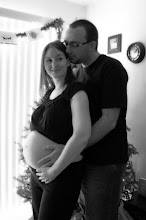Fetal Development This Week
Baby's Lung Development
At nine inches and more than a pound and a half in weight, your baby is taller than two juice boxes stacked one on top of the other, and almost as heavy as four of those little boxes (an analogy you'll find particularly apropos in a few years, when those juice boxes start taking over your refrigerator, your pantry, your car.…).
Don't look now (as if you could), but your baby's skin is turning pinker. No, not because he or she's getting overheated (in fact, the amniotic fluid is perfectly climate controlled, keeping your baby at an always comfortable temperature), but because small blood vessels, called capillaries, are forming under the skin and filling with blood. Later this week, blood vessels will also develop in your baby's lungs, bringing them one step closer to full maturity — and one step closer to taking that first breath of fresh air. But at
25 weeks pregnant, those lungs are still very much works in progress. Though they are already beginning to develop surfactant, a substance that will help the lungs expand after the baby is born, the lungs are still too undeveloped to sufficiently send oxygen to the bloodstream and release carbon dioxide when he or she exhales.
The lungs aren't the only system that's gearing up for air intake. Your baby's nostrils, which have been plugged up until now, are starting to open this week. This actually allows your little one to begin taking practice breaths. (Of course since there's no air in there, your baby is really only "breathing" amniotic fluid, but it's the practice that counts, right?)
Pregnancy Counter at WiddlyTinks.com
What is happening now?
You are now 25 weeks pregnant and at the beginning of week 26.
Your baby's eyelids are no longer fused, so they can now open their eyes and blink! It is also possible for your baby to respond to bright light (such as shining a torch through your belly). Newborns have vision that is perfectly focused from about 20 to 30 cm, usually as far away as the face of the person holding them.
Your baby's movements are generally more regular now and he or she may physically respond to you if you press on parts of their protruding feet, bottom or hands. Some parents play games with their
unborn baby when they seem awake and alert! Your caregiver can now probably hear your baby's heartbeat with a Pinnard's stethoscope (rather than just an electronic Doppler) beating at around 110 to 170 beats per minute.
Babies born between 24 and 26 weeks are regarded as extremely preterm, but have a 50 to 70% chance of surviving if they have access to a fully equipped
intensive care nursery. You can read more about
premature babies here.
Physical Changes
Your growing baby is much larger and now big enough for your caregiver to feel where their head is situated. Your caregiver may even be able to guide your hands during a routine pregnancy visit so you can feel your own baby's head. Ask them to do this next time you see them. Your caregiver may also measure your belly's fundal height.
Babies change position frequently during this phase of pregnancy and are quite often in a
breech position (bottom down) or lying across your belly in a transverse position. Your caregiver may start to write your baby's position on your pregnancy record card.




